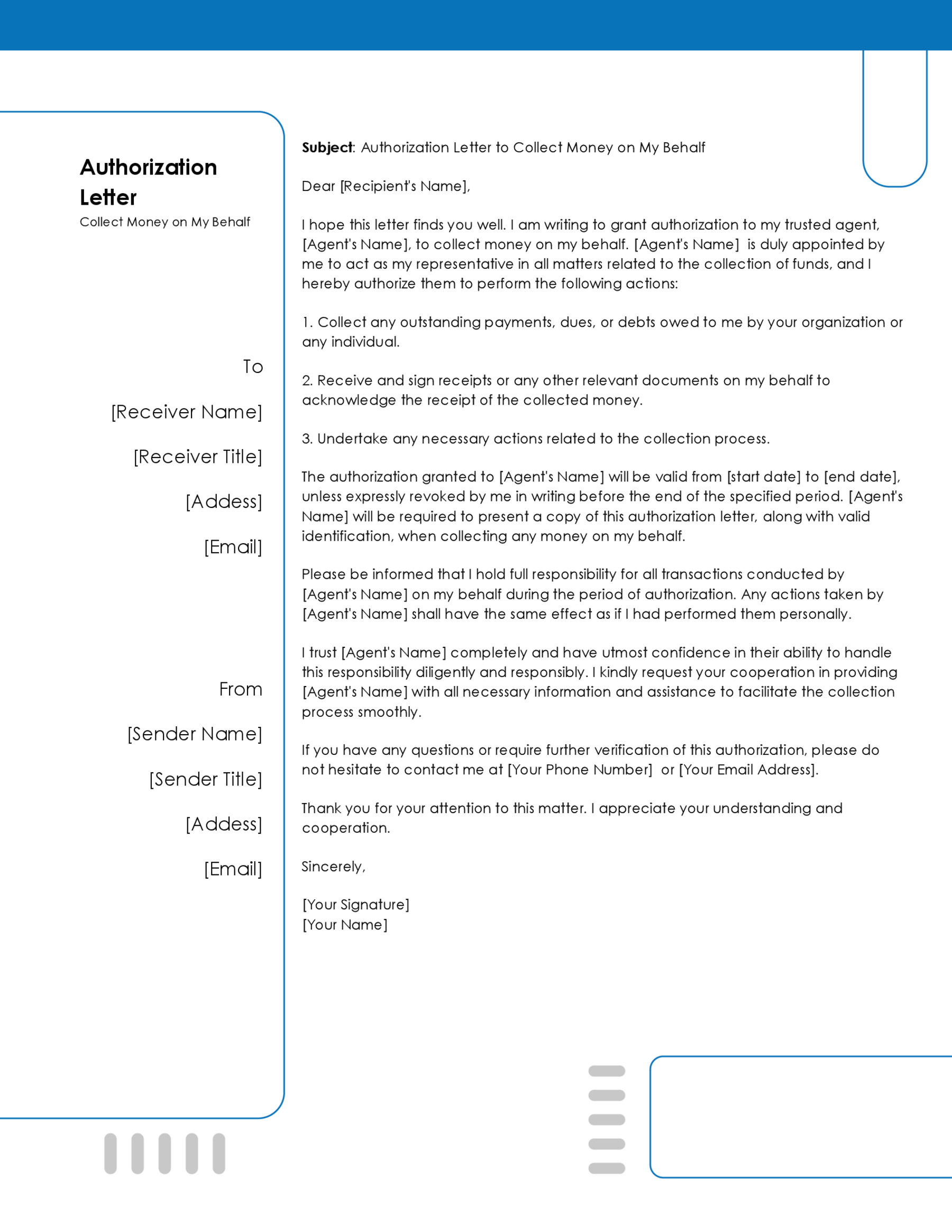Employees’ productivity is often affected by occupational and non-occupational medical conditions or injuries. In such cases, an employee may need a doctor’s letter that explicitly states the employee’s medical condition and any restrictions on their ability to fulfill their work. This could be because of several reasons, including being at risk for injury or illness from performing a role, having an existing medical condition, or suffering from mental health issues. A work restriction letter can be obtained ahead of time if needed, when an employee is injured or falls ill.
A work restriction letter is a document written by a doctor that states the activities an employee should or should not be doing for their role. Its purpose is to provide documentation for recommended modifications, medical conditions, and the duration of the restrictions.
Free Sample Letters
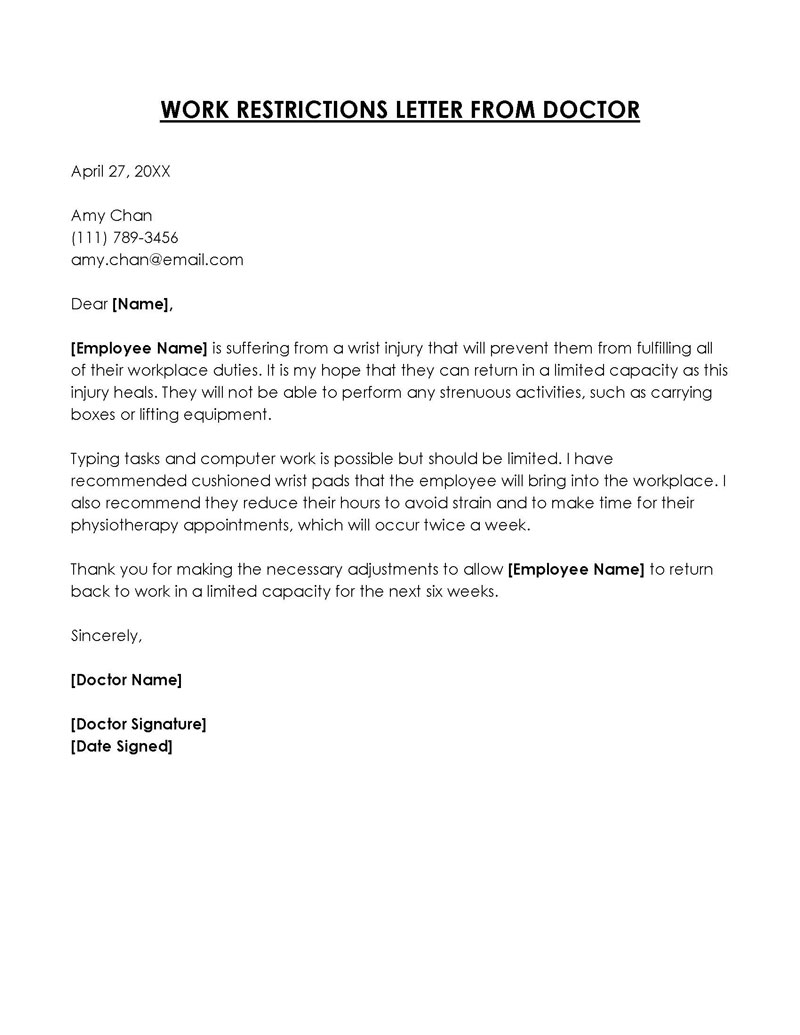
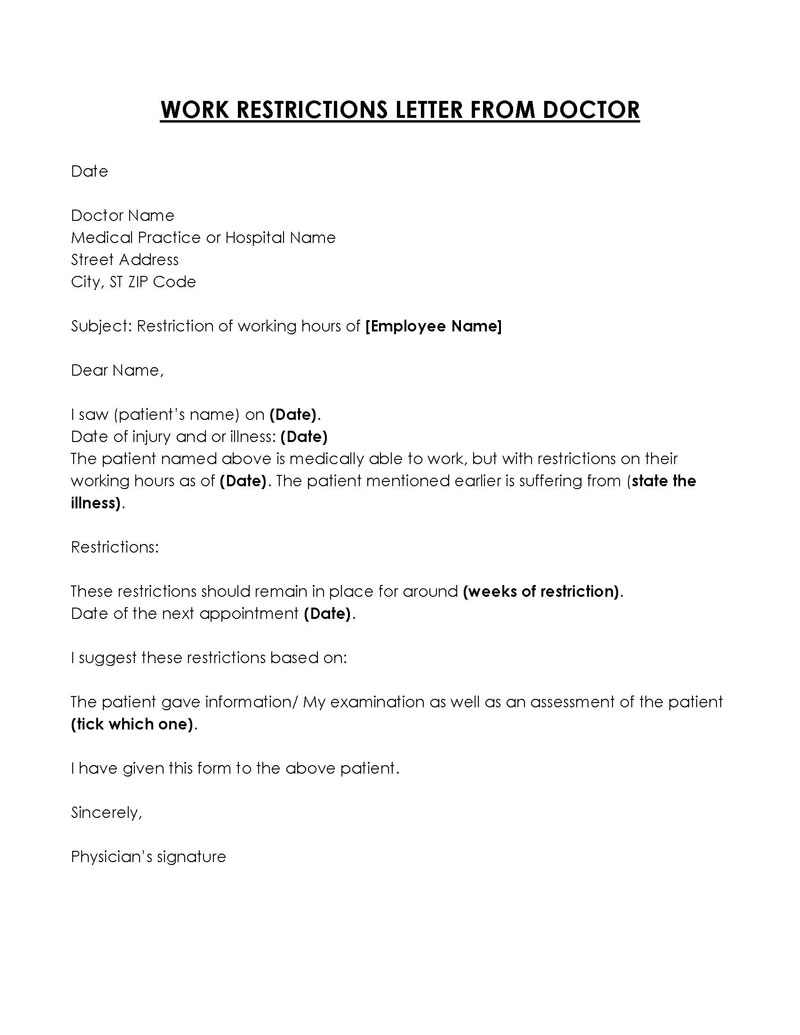
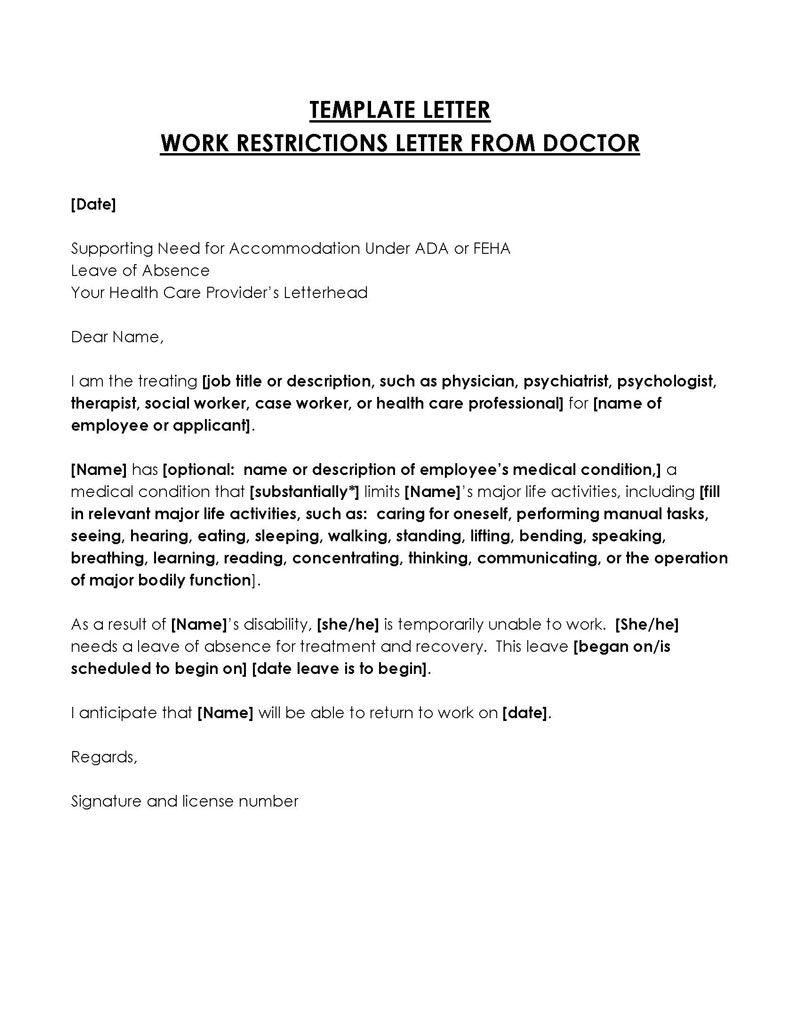
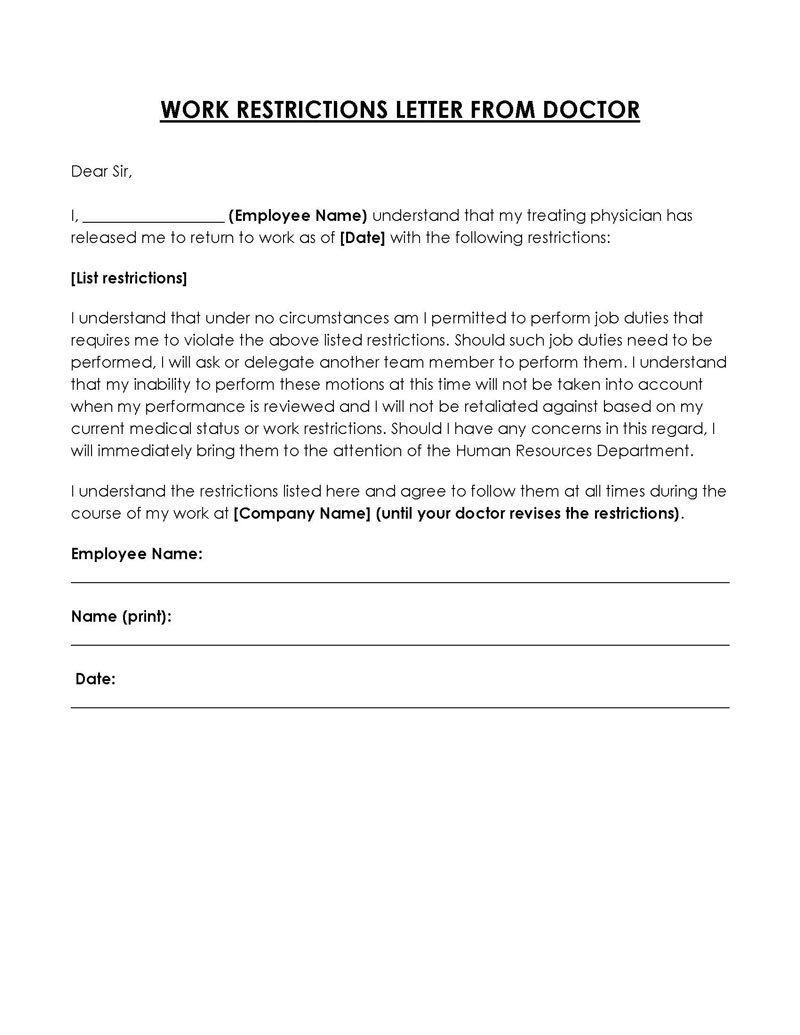
Why and When is it Needed?
A well-written and thorough work restriction letter can increase productivity and positively impact the company. Moreover, it may often be pivotal in an employee’s recovery journey. This is because exposing the body to too much physical and psychological pressure may have adverse health effects, which may cause severe and permanent health issues and potential lawsuits. In addition, they help to return employees safely and gradually.
Most employers require one to inform them about employees’ medical conditions in order to take appropriate action and make arrangements to accommodate them. Employers might also want doctors to specify if there are grounds for terminating the employee if they cannot perform their duties.
These are also used to recruit people with disabilities. The doctor can verify the disability through the document and sign off on what duties the employee is limited to.
Types of Work Restrictions
Work restrictions are referred to by different names, such as transitional work, early-return-to-work programs, light-duty, or modified duty, as discussed below. The type of work restriction is dependent on the nature of the medical condition.
Reduced hours
The employee can be limited to a particular number of working hours. This can be done by awarding them shorter working days in the initial stages of recovery and gradually increasing these hours with time.
Shorter workweek
This involves reducing a whole week’s work to a shorter one. The employer can agree on a weekly schedule, which mandates the employee to take a few days off from the norm. The number of days can be gradually increased as they recover. Shorter workweeks allow the employee to have days for appointments, recovery plans, etc. This can apply to an employee who has been on leave for a long time or is recovering from a severe illness.
Restricted duties
This involves changing the duties of the position by eliminating some tasks usually carried out by the employee but that is not possible because of their medical conditions. The employee’s tasks can be redistributed to other workers or another position in their department. These modifications can be temporary until the employee recovers or permanent, depending on the severity of the injury or illness.
Modified equipment, tools, and workspaces
This involves adapting the work environment to fit the employee’s physical needs. Examples of such equipment include a stool or seat, accessibility channels, special lighting, and desk accessories or tools. The workspace can also be modified by lowering the heights of objects and fittings or relocating them to ensure they are within comfortable reach.
Employer’s Responsibilities Toward Employee
The employer’s responsibility is to provide an environment where all employees can perform their duties safely, effectively, and satisfactorily. The employee’s role and the safety and health risks involved in performing these duties should be discussed with the employee’s supervisor as soon as they are aware of a work restriction. The supervisor should evaluate whether any modifications or adaptations are necessary or if a substitute worker is required. If it is decided that changes are required, they must be implemented immediately.
Employers are thus obligated to accommodate employees with work restriction letters as much as feasibly possible, find alternative and appropriate work for the employee, allow employees to make doctor visits, and offer vocational rehabilitation and training if the employee is no longer able to fulfill their work. Note that work restrictions are not a viable basis for termination of employment, and employers cannot force the employee to work beyond their allotted restrictions.
Injured worker responsibilities
After an injury or illness, the first step is to see a doctor to examine the extent of the injuries or medical conditions. Next, the employee must ensure they sign off on work restrictions if deemed necessary. Once the employee receives a work restriction letter, they must ensure they discuss their medical conditions with their employers and supervisors to ensure they are aware of any potential risks that may come alongside their duties and give the employer enough time to devise the necessary safety measures in place.
Employers can offer an injured worker the option of transfer, reallocation of duties, or providing an alternative position. The consequences of not providing this document to the employer are that the employer anticipates the employee will return to work and carry out their assigned duties as per the employment contract, and failure to do so can warrant termination.
After resuming official duties with a modified work schedule, the employee should perform their duties as directed. If the schedule still impedes the employee’s recovery, they should alert their employer and seek an appointment with the doctor to have the restrictions updated.
What to Include in a Work Restrictions Letter from a Doctor?
It should include an accurate description of the employee’s condition and its consequences for performance.
The following are the most common items that should be considered:
Appropriate salutation
The letter must be adequately addressed, using the name of the person receiving it. This will typically be the employer, and it can be the direct supervisor, HR manager, or any other appropriate representative of the company.
Date and time
It should be dated. This will typically be the date when the letter was created and, consequently, the day of the employee’s appointment with the doctor. In some cases, especially if the note is unavailable, the medical team will place their signatures on blank certificates. The employee must fill in the date when they present it to their employers. The letter should also include the time of the appointment.
Employee name
All letters should name the employee to show to whom their work restrictions belong. In addition, the letter can highlight the employee’s position, date of birth, contact details, and the company where they work.
Identify the injury of the employee
It should indicate the employee’s medical condition and the extent of damage inflicted on them. This can be done by stating the nature of the injury (broken arm, strained back, or slipped back), how it occurs, the intensity, and whether it is permanent or will affect the employee in the future.
Specify the restrictions
The employee’s medical practitioner is bound to mention the physical conditions that require medical supervision for a specified time. These are the limitations that the employee should abide by when performing their duties. In addition, restrictions can be imposed on physical labor or mental input,
EXAMPLE
How much weight they can carry, what tasks are to be avoided, and if protective clothing or equipment is needed. The letter should indicate the expected duration of the work restrictions in a specific period, such as weeks, months, or years.
Recommendations
Before requesting an update or changes to work restrictions, employers must receive recommendations from the doctors to justify their actions. The letter should specify any additional treatment or precautions that the employer must do to ensure an employee’s safety. This could be anything from adjustments to work duties to alterations in work schedules, supervision, and training.
Thanks to the recipient
The letter should include a statement thanking the employer for all their efforts in accommodating the employee’s needs. The letter should also thank them for all the trouble they had to go through accommodating the employee. It must also stress that they will return to work once they recover, if at all possible.
Doctor’s name, signature, and date
The letter should include the name and signature of the doctor who issued it. The date it was issued must also be indicated so that there is no confusion about when the employee was examined.
Template Work Restrictions Letter from Doctor
[Healthcare Provider’s Letterhead]
[Date]
[Employer’s Name or Human Resources Department]
[Company/Organization Name]
[Company’s Address]
[City, State, Zip Code]
Dear [Employer’s Name or HR Department],
Subject: Work Restriction Advisory for [Patient’s Full Name]
I am writing to you in my capacity as [Your Position/Title], the healthcare provider for [Patient’s Full Name], whose health condition has recently necessitated a reassessment of their work capabilities. After a thorough medical evaluation conducted on [Date of Evaluation], it has become necessary to recommend specific work restrictions to ensure their well-being and facilitate their recovery.
Patient Information:
- Name: [Patient’s Full Name]
- Date of Birth: [Patient’s DOB]
- Date of Evaluation: [Date]
- Medical Condition: [General Description of the Condition, ensuring to respect patient confidentiality]
Recommended Work Restrictions:
Based on the medical assessment, the following work restrictions are advised for a period of [Duration of Restriction], starting from [Start Date] to [End Date]. Please note that these restrictions are intended to support [Patient’s Full Name]’s recovery process and prevent any aggravation of their condition:
- [Restriction 1]: [Detailed Description, e.g., limit lifting to no more than 10 pounds].
- [Restriction 2]: [Detailed Description, e.g., avoid prolonged standing, suggesting breaks or alternate activities every hour].
- [Additional Restrictions as Necessary].
Recommendations for Workplace Accommodations:
To support [Patient’s Full Name] in their role while adhering to the above restrictions, I recommend considering the following workplace accommodations:
- [Accommodation 1, e.g., provision of ergonomic equipment or workspace adjustments].
- [Accommodation 2, e.g., flexible scheduling or modified duties that comply with the restrictions].
- [Additional Recommendations as Necessary].
Follow-Up and Re-Evaluation:
A follow-up medical evaluation is scheduled for [Follow-Up Date], at which point [Patient’s Full Name]’s work restrictions and need for continued accommodations will be reassessed. We will provide you with an update following this evaluation.
Please ensure that these restrictions and recommended accommodations are communicated to [Patient’s Full Name]’s immediate supervisor and relevant personnel to facilitate their implementation. It is crucial for [Patient’s Full Name]’s recovery that these guidelines are strictly adhered to within the workplace.
Should you require any further information or clarification regarding these recommendations, please do not hesitate to contact me directly at [Your Phone Number] or via email at [Your Email Address].
Thank you for your understanding and cooperation in creating a supportive work environment for [Patient’s Full Name] during their recovery period.
Sincerely,
[Your Signature (if sending a hard copy)]
[Your Printed Name]
[Your Position/Title]
[Your Contact Information]
Sample Work Restrictions Letter from Doctor
Dear Human Resources Department,
Subject: Work Restriction Advisory for Michael Thompson
As the primary care physician for Michael Thompson, I am writing to inform you of necessary work restrictions following his recent medical evaluation at our clinic on February 25, 20XX. Michael has been diagnosed with a lumbar spine condition that requires immediate adjustments to his work environment and tasks to prevent further injury and facilitate his recovery.
Patient Information:
Name: Michael Thompson
Date of Birth: April 12, 19XX
Date of Evaluation: February 25, 20XX
Medical Condition: Lumbar Spine Condition
Recommended Work Restrictions:
Based on my assessment, the following work restrictions are advised for a period of six weeks, starting from March 8, 20XX, to April 19, 20XX:
- Limit Lifting: Michael should not lift objects weighing more than 10 pounds to avoid exacerbating his condition.
- Frequent Breaks: It is recommended that Michael take a 5-minute break every hour to stand and stretch, reducing the strain on his lumbar spine.
- Avoid Prolonged Sitting: Michael should avoid sitting for more than 30 minutes at a time. An adjustable desk that allows for periods of standing work is recommended.
To support Michael in his current role, I recommend the following accommodations:
- Provision of an adjustable standing desk to alternate between sitting and standing positions.
- Flexible scheduling that allows for physical therapy appointments and necessary medical follow-ups.
- If possible, temporary reassignment to tasks that do not require heavy lifting or prolonged periods of sitting.
Michael is scheduled for a follow-up appointment on April 20, 20XX, to assess his progress and determine if an extension of these restrictions or further accommodations are necessary. We will provide an update following this evaluation.
We kindly request your cooperation in implementing these restrictions and accommodations to support Michael’s health and productivity at work. Ensuring compliance with these guidelines is crucial for his recovery and prevention of further injury.
Should you require further information or clarification regarding Michael’s condition and the recommended work restrictions, please feel free to contact me directly at (555) 987-6543 or via email at emily.stanton@stantonpractice.com.
Thank you for your attention to this matter and for your support in creating a safe and healthy work environment for Michael during his recovery period.
Sincerely,
[Signature]
Dr. Emily Stanton, MD
Stanton Family Practice
(555) 987-6543
Key Takeaways
This letter effectively communicates a medical condition and necessary work adjustments without mentioning specific names. Here’s why it’s effective:
Clear Identification of Medical Condition: The letter clearly identifies the medical condition and specifies the recommended work restrictions without mentioning individual names. This ensures confidentiality while providing essential information for the HR department to act upon.
Detailed Recommendations: Specific guidelines such as limiting lifting weight, taking frequent breaks, and avoiding prolonged sitting are provided, offering clear instructions for accommodating the employee’s needs without disclosing personal information.
Accommodation Suggestions: The letter suggests practical accommodations like providing an adjustable standing desk and offering flexible scheduling for medical appointments, demonstrating consideration for the individual’s well-being without revealing their identity.
Professional Tone: Maintaining a professional tone throughout the letter enhances its effectiveness. It conveys the seriousness of the medical situation and the importance of compliance with the recommended adjustments without disclosing private information.
Follow-up Plan: Mentioning a follow-up appointment indicates a commitment to monitoring progress and adjusting accommodations as necessary, promoting ongoing support for the employee’s health and productivity without disclosing their identity.
Contact Information: Providing contact information for further inquiries allows for easy communication between the medical provider and the HR department while maintaining confidentiality.
Overall, the letter effectively balances the need for privacy with providing necessary information and recommendations to support the employee’s health in the workplace.
Legal Matters and Privacy Laws Under HIPAA
The following are legal considerations worth looking into when utilizing a work restriction letter from a doctor.
EXAMPLE
HIPAA laws stipulate that if a doctor wants to release the employee’s information to the employee’s employer, the patient must consent or sign a release of information to share medical records.
FMLA protection
Suppose the employee is covered under Federal labor laws such as the Federal Workers’ compensation act, the unemployment benefits act, the federal employees’ compensation act, etc. In that case, their employer is obligated to follow all procedures mandated by the law. In addition, these laws guarantee workers are protected from dismissal due to absence from work due to medical conditions.
Court’s decision
If an employee has given their employer a qualified letter stating the worker is restricted from performing their duties, the employer must do all they can to accommodate and adjust for such an employee. The judge ruled that a letter is sufficient to prove that an employee cannot return to work as long as it has been indicated in the note. After that, it is up to the employer to comply with FMLA laws.
ADA (Americans with Disabilities Act)
The ADA prohibits employers from victimizing individuals with disabilities. This law implies that employers should accommodate qualified disabled employees who present a doctor’s letter. Employers are thus legally obligated to provide reasonable accommodations for employees with disabilities.
Frequently Asked Questions
There are particular instances when it may be difficult for an employer to adjust or accommodate an employee with limitations, such as when there are limited resources and capabilities available in the organization. In such cases, they can find alternative positions to accommodate the employee or offer them options to participate in vocational rehabilitation to train for other roles.
If an employee is unable to perform their duties due to work restrictions as stated in the doctor’s letter, the employer may be held liable for violating the Fair Labor Standards Act and the Disabilities Act. Such employers could be subject to fines and other penalties. Employees should thus consult an attorney to guide them on the way forward.
In such a case, the employee may be entitled to file a legal grievance against the employer. It is thus prudent to consult a lawyer.
A permanent work restriction indicates a limitation in the employee’s ability to perform their duties from the onset. They usually refer to limitations on an employee’s physical capacity, intellectual ability, or mental faculties. Such a condition is considered long-term and will likely affect the employee’s future performance in the organization.
An employer cannot legally deny work to an employee due to medical restrictions if the job restrictions are temporary as stated by in the doctor’s letter. However, if the employee is unqualified for a particular job in the organization due to medical restrictions, then such an employer would not be required or expected to hire or even retain such an employee. Therefore, they might have to compensate the employee on a temporary disability basis.
Legally, employers within at-will employment laws can fire employees due to medical issues even if they have submitted a doctor’s letter and followed the appropriate procedure. However, employees can always counter with a lawsuit. Prolonged medical leaves often prompt termination of employment.
In legal terms, the only time employers cannot reject a doctor’s letter is when an employee is taking the medical leave following FMLA laws which allow employees to take an absence from work of up to 12 weeks. However, if there are no state laws governing doctor’s letter, the employer should use company policies that may or may not allow them to reject the doctor’s letter.
An injured worker is expected to report back to work once their employer provides them with a light-duty opportunity. However, if the employee does not wish to return to work in such a condition, they are allowed to. Unfortunately, this may often mean they lose their right to compensation.
You should request a report of workability or updated work restrictions whenever you visit them during your recovery period. It would be best to ask for specific instructions that do not create more questions than answers.
It would be best to abide by the work restrictions after notifying your employer. However, if the restrictions are still straining your health, you can opt to seek further modifications through your employer.
Yes. Employers can request a doctor’s letter whenever an employee is absent from work due to medical issues. The policy must, however, apply to all employees. Employers cannot request specific employees to submit one and give others a pass.











